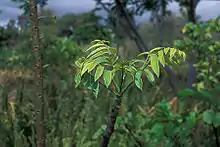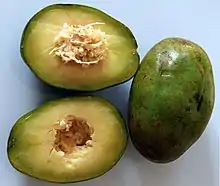Spondias dulcis
Spondias dulcis (syn. Spondias cytherea), known commonly as ambarella (ඇඹරැල්ලා) in Sri Lanka or June plum, is an equatorial or tropical tree, with edible fruit containing a fibrous pit.
| Spondias dulcis | |
|---|---|
 | |
| Scientific classification | |
| Kingdom: | Plantae |
| Clade: | Tracheophytes |
| Clade: | Angiosperms |
| Clade: | Eudicots |
| Clade: | Rosids |
| Order: | Sapindales |
| Family: | Anacardiaceae |
| Genus: | Spondias |
| Species: | S. dulcis |
| Binomial name | |
| Spondias dulcis | |

Description
This fast-growing tree can reach up to 20 m (66 ft) in its native range of Melanesia and Polynesia; however, it usually averages 10–12 m (30–40 ft) in other areas. Spondias dulcis has deciduous, pinnate leaves, 20–60 cm (8–24 in) in length, composed of 9 to 25 glossy, elliptic or obovate-oblong leaflets 9–10 cm (3.5–3.9 in) long, which are finely toothed toward the apex. The tree produces small, inconspicuous white flowers in terminal panicles. Its oval fruits, 6–9 cm (2.4–3.5 in) long, are borne in bunches of 12 or more on a long stalk. Over several weeks, the fruit fall to the ground while still green and hard, then turn golden-yellow as they ripen.[1] According to Morton (1987), "some fruits in the South Sea Islands weigh over 500 g (1 lb) each."[1]
Habitat
Spondias dulcis has been introduced into tropical areas across the world. It was brought to Jamaica in 1782, and it is cultivated in Panama, Cuba, Haiti, the Dominican Republic, Puerto Rico, Trinidad and Tobago, St. Lucia, and eastern Sucre in Venezuela. The United States Department of Agriculture received seeds from Liberia in 1909, but it did not become a popular crop in the US. Nevertheless, it is grown in South Florida as far north as Palm Beach County. The fruit is also widely grown in Somalia's agriculture belt, probably introduced during the colonial times preceding 1960.[2]
As food
Spondias dulcis is most commonly used as a food source. In West Java, its young leaves are used as seasoning for pepes. In Costa Rica, the more mature leaves are also eaten as a salad green though they are tart. However, it is most commonly used for its fruit.
The fruit may be eaten raw; the flesh is crunchy and a little sour. According to Boning (2006): "The fruit is best when fully colored, but still somewhat crunchy. At this stage, it has a pineapple-mango flavor. The flesh is golden in color, very juicy, vaguely sweet, but with a hint of tart acidity."[3] In Indonesia and Malaysia, it is eaten with shrimp paste, a thick, black, salty-sweet sauce called hayko in the Southern Min dialect of Chinese. It is an ingredient in rujak in Indonesia and rojak in Malaysia. The juice is called kedondong in Indonesia, amra in Malaysia, and balonglong in Singapore.
The fruit is made into preserves and flavorings for sauces, soups, braised and stews. In Fiji it is made into jam. In Samoa and Tonga it is used to make otai. In Sri Lanka the fruit is soaked in vinegar with chili and other spices to make acharu. In Vietnam the unripe fruit is eaten with salt, sugar, and chili, or with shrimp paste. Children eat the fruit macerated in artificially sweetened licorice extract. In Jamaica, it is mostly considered a novelty, especially by children. It can be eaten with salt or made into a drink sweetened with sugar and spiced with ginger. It is also used to make juice in Grenada. In Trinidad and Tobago, it is curried, sweetened, salted, or flavored with pepper sauce and spices. In Cambodia it is made into a salad called nhoam mkak (/ɲŏam məkaʔ/ ញាំម្កាក់). In Suriname, the fruit is dried and made into a spicy chutney, mixed with garlic and peppers. In Thai cuisine both the fruits and the tender leaves are eaten.
Vernacular names
- Adavi Mamidi — Telugu
- Amra Kai (மாரிமா) — Tamil
- Ambade — Tulu
- Ambado — Konkani
- Ambarella (Sinhala: ඇඹරැල්ලා)
- Ambarella — Dutch
- Ambazhanga — Malayalam
- Amokana — Hokkien
- Amrah (अमरा/امارا) — Caribbean Hindustani and Fiji Hindi
- Amra (আমড়া), Biliti — Bengali
- Amte kai — Kannada
- Anbulha އަނބުޅަ — Dhivehi language, Republic of Maldives
- Balolong — Cebuano language, (Philippines)
- (Buah) Kedondong — Malaysian, Indonesian and Sarawakian Malay
- Buah Long Long — Singlish
- Caja Manga — Brazil
- Casharana — Peru
- Cas Mango — Cameroon
- Chook-chook plum — Sierra Leone
- Cóc — Vietnamese
- Embe ng'ong'o — Tanzania
- Evi — Réunion
- Fruit de Cythère — Mauritius
- Frisiter — Mauritius, Seychelles
- Golden apple — Saint Kitts and Nevis, St Lucia, Barbados, Guyana, Saint Vincent and the Grenadines, Grenada
- Goldpflaume — German
- Golden plum — Belize, Liberia
- Green Jungle — Papua New Guinea
- Gway — Burmese
- Heining – Meitei
- Hevi — the Philippines
- Isbaandhays or Isbaandhees — Somali, Somalia
- Jocote de Mico — Guatemala
- Jobo indio — Spanish
- June Plum — Jamaica, Bermuda
- Makok farang (มะกอกฝรั่ง) — Thai
- Manga zi nsende — Kikongo
- Mangotin — Panama
- Manzana de oro — Dominican Republic
- Mkak (ម្កាក់) — Khmer
- Naos — Bislaman
- Omora (অমৰা) — Assamese
- Pommisitair — Suriname
- Ponm sité, pomme cythère — Dominica
- Prune de cythère, pommecythere — French West Indies (Martinique, Guadeloupe), Guyane, Trinidad and Tobago
- Spandes - Somalia
- Sakoa — Malagasy
- Umbra — Malaysia
- Tamzinthai — Rongmei
- Vī — Samoan and Tongan
- Vi kavakava — Cook Islands Maori
- Wi — Fijian
- Wi apple — Hawaiian
- Ciruelo _ Ecuador
References
- Morton, J. Ambarella. Center for New Crops & Plant Products. Purdue University. 1987.
- Boning, Charles (2006). Florida's Best Fruiting Plants. Sarasota, Florida: Pineapple Press, Inc. pp. 22–23.
- Boning, Charles (2006). Florida's Best Fruiting Plants: Native and Exotic Trees, Shrubs, and Vines. Sarasota, Florida: Pineapple Press, Inc. p. 23.
External links
![]() Media related to Spondias dulcis at Wikimedia Commons
Media related to Spondias dulcis at Wikimedia Commons